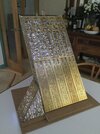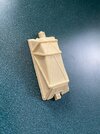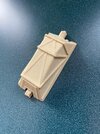So, a few notes about buttress. I mentioned in a previous post that that chamfered baton at the bottom of the buttress is extremely important to anchor and support the weight of the model. I also put the same inverted baton at the back because the downward force of the model tends to push the bottom upward and slide backwards. That’s just physics.
Also ,on the original model ,the baton went right across the face of the wedge as well. I didn‘t think this was necessary since the wedge is self supporting. So I put a smaller baton just to keep it in position.
The top of the wedge is a contentious also. I have a good reference ( which I can’t publish) which shows the roof of the wedge was detailed with strip and various patterned styrene. It didn’t look right or comparing it to the beautiful detailed roof, it just looked rough. But on some images it looks as though the etch was carried downward and over the wedge roof. Thats the approach I took here and it looks .... appropriate.
And finally about the etch on the sides and on the wedge. Originally this was glued directly to the acrylic light box and painted( and you can see Chris Ross in some online images touching up with a spraygun. What I havent confirmed is that did they scratch the window lights into the paintwork afterwards. It’s a mystery. I found a solution to this by dealing with it the same as the large front elevation, keeping the etch and light patterned artwork seperate.
Also, my wife threatened to beat me over the head with a baseball bat if I put paint on the brass etch.
Its evening, another image.
I’ll update on the roof next week.




